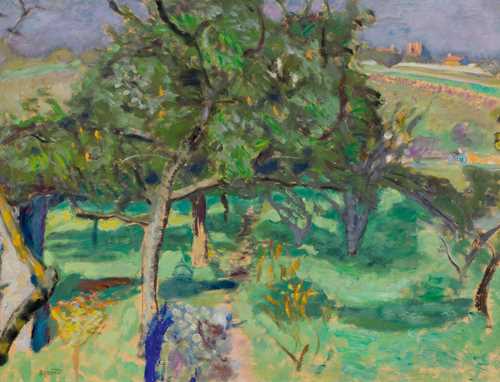
Lot 3226* - Z41 Impressionist & Modern Art - Friday, 02. December 2016, 02.00 PM
PIERRE BONNARD
We thank Dr. Bettina Best for her scientific support.
Provenance:
- Estate of the artist.
- Private collection, Paris.
Literature:
- Dauberville, Jean/Dauberville, Henry: Bonnard. Catalogue raisonné de l'oeuvre peint, vol. IV, 1940-47 et supplement, Paris 1974, vol. IV, no. 01949, p. 285 (with ill.).
- Cahn, Isabelle: Bonnard. Peintre l'Arcadie. Exhib. cat., Musée d'Orsay, Paris 2015.
From 1909, Bonnard travelled almost every year to the Midi. In June of 1909 he travelled to the Côte d’Azur for the first time. Fellow painter and friend Henri Manguin had invited him to Maleribes, today a suburb of St. Tropez. Bonnard and Manguin shared a passion for nature, landscape and colour.
Bonnard returned again and again to St. Tropez, Grasse, Cannes and Le Cannet, until, in 1926, he bought himself a small house in the hills above Cannet with a view of the Mediterranean, which he christened “Le bosquet” (the wood grove). There he spent the best part of his twilight years until 1947.
During Bonnard’s first visit to the Midi, he created the present painting of landscape, trees and fruit trees. This peaceful and light-filled place inspired Bonnard towards the glowing sensuousness and vitality of colour. The painter transformed himself into a magician of colour. His palette became lighter, the landscape became a lived environment of the open air, and his pictures captured that power of colours, which remain sharp and true: blue shadows, yellow meadows, orange leaves, intensely hued sky, ultimately replaced the hitherto muted palette of the Paris-based painter.
In contrast to the pictures by his friend Henri Manguin, we can call Bonnard’s creations “constructed pictures”. These are spaces in which the imagination can unfold. In our painting, the framework of branches sinks into the darkness of the foliage to become a cooling blue dense mass – the external space of the garden contrasting with the internal space of the tree crown. Beneath the shady canopy, the path in the meadow becomes lost, its edge marked by the peasant woman bent over her work at the front edge of the picture. Thoughts may stroll along this path, becoming lost in the distance with sleepy daydreams in a sensuous garden paradise, where the golden orange radiates summer heat.
In his typical way, the painter has divided the largescale landscape into various sections: the crowns of the trees, the background, a strangely abstract triangular form on the left edge of the picture, and a section rendered in loose brush strokes in the upper left corner. A street marks the limit of the sunny area of fields leading into the distance. On the other side, the red roofs of the houses of Maleribes gleam overhead, leading one’s gaze from the height of the hill of Villa Demière down and up again into the breadth of the sky: along the elevated horizon, our idyllic rustic garden marks the edge of this self-contained cosmos.
The painter has depicted each section from a different vantage point. They stand together as in a collage, and, in an extraordinary way, they convey a total impression of a space, which certainly the human eye could encompass, but not the photographic lens. Bonnard himself called this compositional method an “adventure of the optic nerve”. In our picture, the spatial interlacing and ambiguous positioning of the various sections, run contrary to the ostensible impression of harmony. The subtle interplay of various spatial effects and nuanced colouring brings time to a halt in a moment of Arcadian fulfilment.
The scene in our painting - landscape, trees and fruit trees - was depicted again by Bonnard in his work of almost the same dimensions – “Le Linge”. Jean und Henry Dauberville date this and our painting to the period around 1909. Both paintings come from the artist’s estate and are included in the supplement to the catalogue raisonné under numbers 01948 and 01949.
CHF 80 000 / 120 000 | (€ 82 470 / 123 710)
Sold for CHF 132 500 (including buyer’s premium)
All information is subject to change.

